Tiny Towns – We build tiny cities for critters
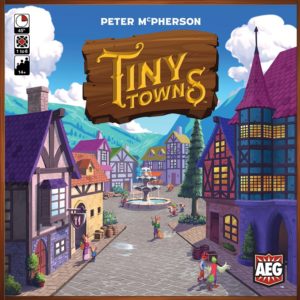 If everyone helps, the construction of the new country houses will be done quickly. There is a little bit of wood and here a little bit of clay and then all that is needed is glass for the windows and the work is done. Wait, what am I supposed to do with this metal? I said I need glass. All right, no problem, put the metal over there. We can build the factory there. What, there’s no place to store it? And now the requested glass, we can’t use that right now! First of all the metal has to get away, so that the glass has space and we can finish building the little country house. There is simply not enough space here, so this will not work!
If everyone helps, the construction of the new country houses will be done quickly. There is a little bit of wood and here a little bit of clay and then all that is needed is glass for the windows and the work is done. Wait, what am I supposed to do with this metal? I said I need glass. All right, no problem, put the metal over there. We can build the factory there. What, there’s no place to store it? And now the requested glass, we can’t use that right now! First of all the metal has to get away, so that the glass has space and we can finish building the little country house. There is simply not enough space here, so this will not work!
Board games in which cities are built are always well received in the board game scene. Tiny Towns by Peter McPherson takes up this topic and thanks to the publisher AEG, we are allowed to play city planner once again. But somehow there is something different about this board game. Everything is tighter and quite tricky and puzzling. We took a closer look at Tiny Towns. In our review we want to explain to you why setting a single wooden cube at the beginning of the game can already mean the lose for you.
We build Tiny Towns
The title is program. At the beginning I don’t have much, only a free meadow with 4×4 fields. And there I shall erect all buildings. Sure, that’s no problem for an experienced veteran player who has already built countless futuristic, roman and medieval cities. Well, 20 minutes later it shows that it can be difficult. I’ve never had to plan so much in advance in a game about city building as I did in Tiny Towns.
The rules are quite simple: One card is drawn from a deck of resource cards and laid out face up for all to see. Now each player takes the corresponding resource and places it on one of the 16 free spaces of his small game table. Once I have collected patterns of raw materials for a building, I replace all raw materials with the building I place on one of the newly vacant squares. If I can no longer place any raw materials, the game is over for me and I can start counting the points. This is a rough sketch of what Tiny Towns is all about. Actually, it’s not very difficult.
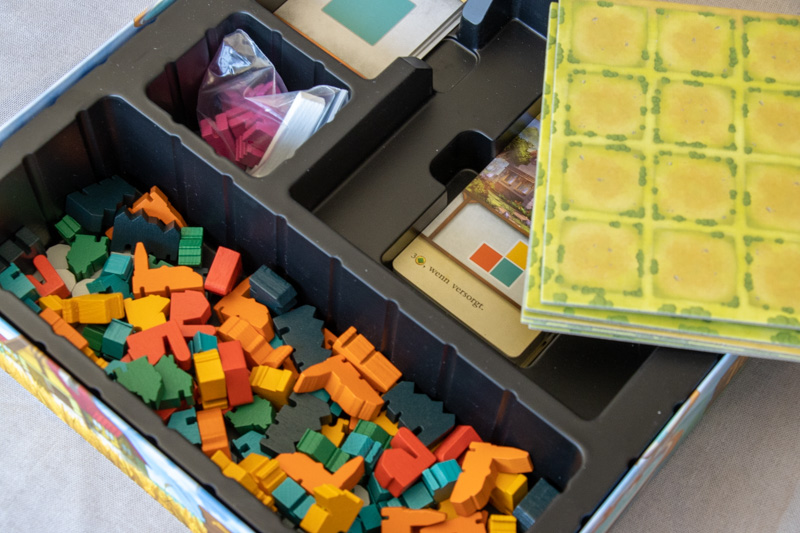
A look at the details
Of course, simply placing raw materials and then exchanging them for houses would not be a really great achievement for a board game. But Tiny Towns takes a slightly different approach here. Like many games from AEG lately, it seems that they take a proven game principle and then spice it up a bit. With Space Base it was Machi Koro and with Custom Heroes it was the trick gameplay. So now the simpel resource exchange is taken as a guideline. Because it’s not quite that easy to build my tiny town.
In the beginning, five different buildings are selected from a deck of cards, each one belonging to a different category. What I always have available are the country houses, somewhere my little inhabitants have to stay overnight. But building only country houses does not help me at all, because a country house is worth 0 victory points. Only when it is supplied, I get 3 victory points at the end. It’s a good thing that there are other buildings for the supply of the houses. An example would be the farm: But it only supplies 4 country houses on the small game board. So if I have five country houses, I need another farm. Better than the farm, however, is the granary, as it supplies eight country houses. The disadvantage of the granary is that all the country houses must be adjacent to it.
Which of the four possible supply buildings is in play is determined randomly at the beginning of the game. Thus the building types already determine how my city should look like. This also applies to all other building types besides the supply buildings and so I have to build the city differently each time.
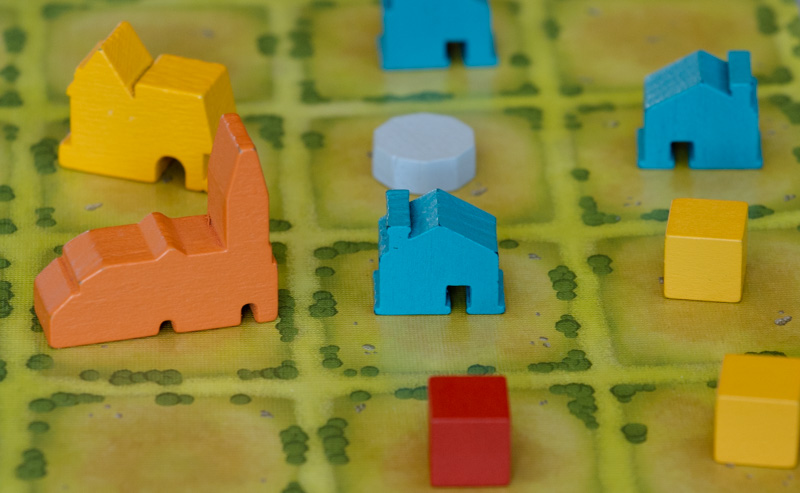
The thing about luck
This is the puzzle part, and it could be solved quite easily and very barren with mathematics. Because the individual building types are the well-known Tetris shapes, which have already made it into a board game one or the other time. But that it is not so easy is in the nature of things. For the Settlers of Catan, a dice ensures from the beginning that there is a small element that cannot be calculated. In Tiny Towns, these are the resource cards. The deck with the cards is shuffled again and again when it is empty. However, this is not random enough.
Because at some point the raw material I need has to come, so I can also do mathematics here. But this is not the case, because after shuffling, five cards are removed from the deck and put aside unseen. And then the whole thing becomes more dependent on luck. Are there still enough brick cards in the deck to build my houses as I imagined them? And when are they coming? As you know, space is limited, so the right resources must come at the right time. If I’m unlucky in drawing the resources here once, it can trigger a stupid chain. I can’t build the building I wanted to build. And that leads to the fact that the space is not released etc, etc.
To make it not quite so unfair, there is a small bonus every three rounds. Here I get to choose my raw material. This gives me back a little bit of control over randomness. However, it doesn’t always help me, especially towards the end when the space gets tighter and tighter.
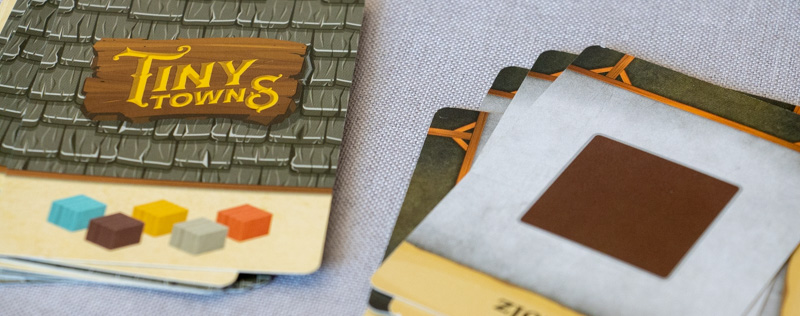
Tiny Towns together alone
So we are all puzzling along and expanding our tiny towns. But it’s not really a we. Everyone builds alone. And this is one of the criticisms of Tiny Towns. There’s no player interaction. Whether or not my opponent builds his house is decided only by the cards and his own planning skills. In fact, I can actually break the game. I just have to place the resources in the same way as my opponent. If everyone at the table imitates their neighbour, everyone gets the same points. Of course I don’t do it consciously. I know that I’m a better city planner than the other players. And since I have the overview, I do my own thing.
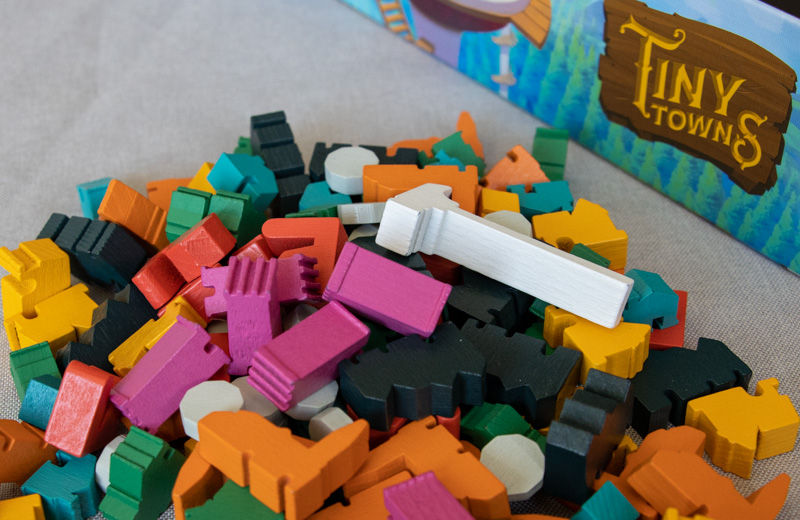
Another thing I didn’t like about Tiny Towns was the strong smell of the components. Our copy still has a very strong, acrid smell of chemicals even after some games. Here it reminds me strongly of Victorian Masterminds, where we had to ventilate the game first. However, washing up with dishwashing liquid, which soothed the smell with Victorian Masterminds, unfortunately doesn’t work with the wooden parts of Tiny Towns.
The number of resources and game elements can also quickly reach its limits. There are 24 country houses. If you play Tiny Towns with only four players and the above-mentioned granary comes into play, you would actually need 32 country houses if all players placed all their houses skillfully enough. So we had to resort to suitable replacements in some games.
Also, the absence of a marker or several markers to indicate the current round would not have hurt. Especially in the beginning we got confused quite often concerning the number of rounds. Since we are allowed to choose our own resources every third round, a tool for this would have been quite handy. So now we help ourselves by putting the cards on the discard pile 90 degrees apart, depending on the round. This works, but it’s not really the optimum.
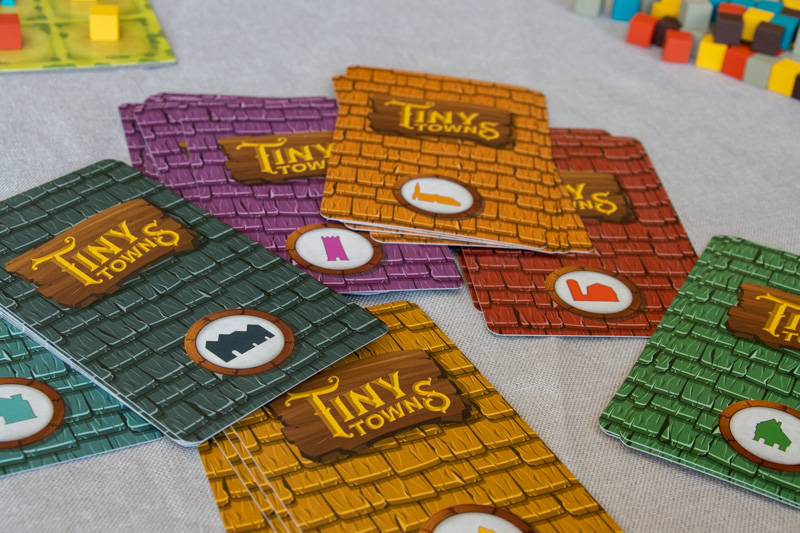
The good places in Tiny Towns
But Tiny Towns is by far not a bad game because of the points mentioned. Quite the opposite: Puzzling and placing the raw materials is a lot of fun. In addition there is also the luck component. How far do I gamble for the points? Because one thing I’ve already determined very quickly: If I play it safe, I’ll never compete for victory. I have to take a risk. But if you take a risk, you can also lose something. So extreme points in Tiny Towns are definitely part of the game. One time I win by a huge lead and the other time I lose and I’m happy to have brought home just 0 victory points.
Very often the winning and losing is decided in the first round, because I have to pay attention. Often enough I have already placed a raw material at the beginning of a game just like that, without thinking too much about it. This only led to me cursing myself two or three rounds later. Only then did I realize that the unclaimed raw material will leave me with a gap on the tableau, which I can’t close during the game. But that’s exactly what belongs to Tiny Towns. Joy and anger are very close together here. Because as much as a wrongly placed resource annoys me, I’m happy like a little child when the right cards are drawn and the planned placement of all houses works.
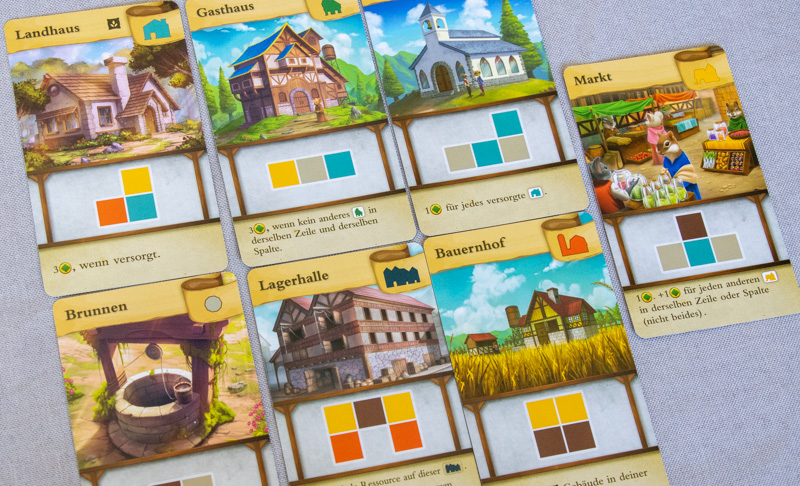
Small rules for a big board game
At this point I would also like to emphasize the instructions for the game. It’s really well done and thanks to it I got into the game quickly. Sure, for a game like Tiny Towns, which is not a mechanical monster, it doesn’t need much. But the instructions are a mirror of the game: short and clear, so that I can simply play quickly.
Due to the different buildings, the replay is also quite high for me. Of course, here I realize that there are some combinations that simply harmonize better with my city planning and others where I have to decide on a strategy right at the beginning if I want to score. And if at some point that’s no longer enough for me, the rules also offer further variations. Once a new type of building comes into play, which is only available to me, or the resource cards are no longer used because the players in turn decide which resources are distributed in a round. Personally, I like the standard variation because it is exactly right for me with its random and puzzle elements I have enjoyed it the most until now.
In addition, Tiny Towns always fits, whether as a game at the beginning of a game evening or as a nightcap or just between two games.
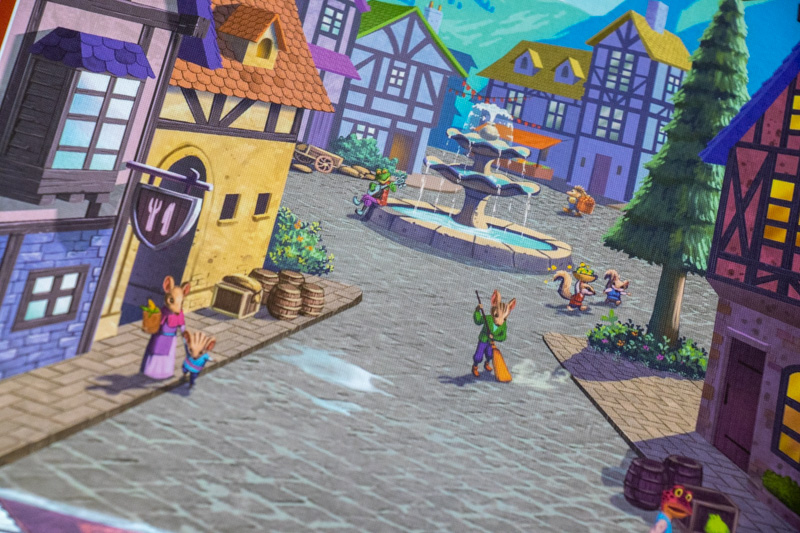

/pic4460401.jpg)
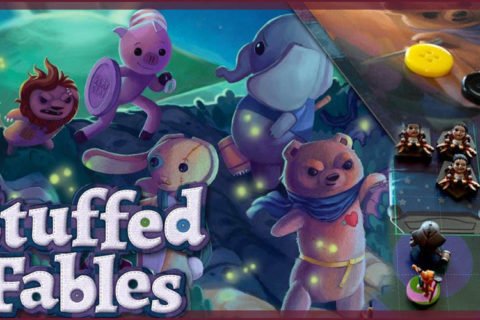
Leave a Reply